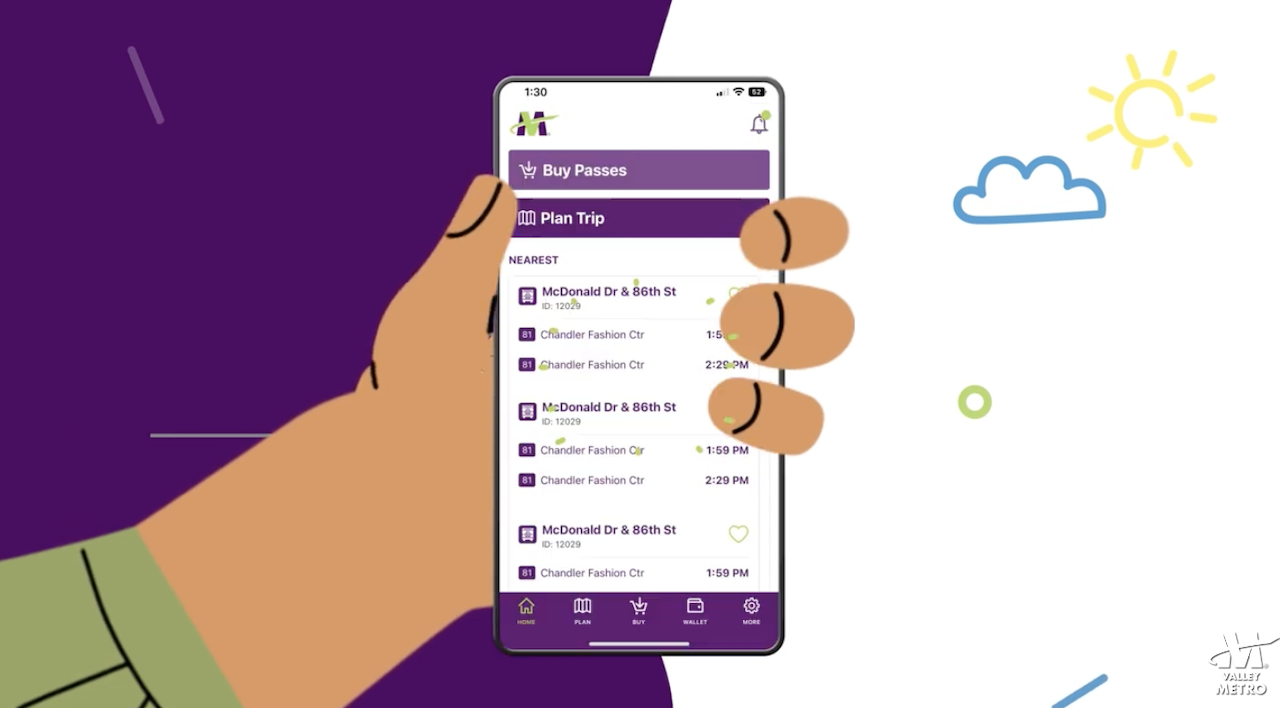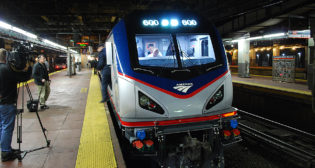
Transit Briefs: Calif. HCD/DGS, LA Metro, Sound Transit, Valley Metro
Written by Carolina Worrell, Senior Editor
Mobile fare is now available in the Valley Metro app.
Gov. Gavin Newsom announces three state sites identified for affordable transit-oriented housing in Sacramento. Also, LA Metro will add 93 billboard-size digital signs across the city; Sound Transit adopts $1 ORCA LIFT fares; and Valley Metro announces that mobile fare is now available on the agency’s app.

Calif. HCD/DGC
Gov. Newsom on Jan. 31 announced that the California Housing and Community Development (HCD) and the California Department of General Services (DGC) are seeking qualified developers to transform state-owned properties into transit-oriented housing.
In keeping with the Governor’s 2019 Excess State Lane Executive Order (N-06-19), three state office buildings along Capitol Mall in downtown Sacramento will be made available for housing.
HCD and DGS issued a Request for Qualifications (RFQ) to redevelop the headquarters of the Employment Development Department (EDD) at 800 Capitol Hill, the EDD Solar Building at 751 N Street, and the State Personnel Board Building at 801 Capitol Mall.
According to the Office of the Governor, California needs to plan 2.5 million homes over the next eight-year planning cycle, no fewer than one million of which just meet the needs of lower-income households. Opening up excess state properties for conversion to housing, the Office of the Governor says, “can help spark the production of sustainable, innovative and cost-effective housing.” So far, the Governor’s Executive Order has resulted in 16 public-private partnerships between the state, affordable housing developers and local communities and amassed a pipeline of more than 5,000 new rental units in various stages of development.
“In California, we are taking every opportunity and using every tool available to build more housing, faster–including reviewing our own portfolio of excess land to transform state property into housing,” said Gov. Newsom. “Our excess land strategy is part of a multipronged approach to tackle the housing crisis in California, which includes greater accountability, streamlining the building process and providing incentives along with unprecedented resources to communities willing to step-up and meet their housing commitments.”
Tenants at the three downtown Sacramento state office buildings are expected to relocate to new facilities in 2025. Once vacant, the properties along the Blue and Green Sacramento Regional Transit light rail lines will be unlocked for potential development into new transit-oriented affordable housing.
A DGS-commissioned study of the EDD headquarters in 2020 found that adaptive reuse—modernizing and converting the existing office buildings into housing—could potentially produce nearly 400 climate-smart one-, two-, and three-bedroom homes for lower-income households.
For the Capitol Mall properties, HCD and DGS are interested in receiving statements of qualification for adaptive reuse of the existing office buildings but will “consider alternative development visions should they better address the Executive Order’s guiding principles of affordability, construction cost efficiency, innovation, sustainability, and racial equity.”
Developers selected by HCD and DGS, according to the Office of the Governor, would receive a long-term ground lease from the state to build, own, and manage the housing they develop, subject to oversight from the state. Under the order, the two departments will continue to identify and prioritize state-owned excess sites for sustainable, innovative, and cost-effective housing.
The Request for Qualifications can be found here.
LA Metro
LA Metro’s transit communications and advertising program, which includes putting up 93 billboard-size digital signs across the city, was approved last week by the agency’s Board of Directors, according to a Los Angeles Times report.
According to the Los Angeles Times report, the program, which has the potential to generate $300 million to $500 million in advertising income over a 20-year span, has been billed as a way to “make traffic move more smoothly by giving drivers public safety alerts and information on bottlenecks.”
According to the Los Angeles Times report, seven out of every eight images on the digital signs would show advertising, said Metro Senior Executive Officer Holly Rockwell, who oversees the agency’s real estate program. The ad revenue, she added, would be split 50-50 with the city with proceeds going to pay for bus, rail and other transportation programs.
Opponents of the program say the signs—many of them 48 feet wide, with images changing every eight seconds—will “undermine the city’s existing restrictions on digital billboards,” the Los Angeles Times reported. “L.A. streets, which had more than 300 traffic deaths last year, will become even more perilous for bicyclists, drivers and pedestrians, those opponents say.”
According to the Los Angeles Times report, Metro’s environmental team reached a different conclusion, saying it found “no correlation between the digital billboards they plan to install and traffic safety.”
According to the Los Angeles Times report, “backers of Metro’s sign program said at least two square feet of existing non-electronic billboards would be taken down each time one square foot of digital signs goes up. That effort will ‘greatly reduce the total number of signs on Metro property while providing Metro passengers and the public with real-time information on travel conditions,’ said Hugh Esten, Spokesperson for City Council President Paul Krekorian, who serves on the agency’s board.”
Metro officials said they view the “two-to-one takedown ratio as a minimum—and hope to remove a greater amount of billboard space in the coming years,” according to the Los Angeles Times report, which adds that opponents are contemplating a legal challenge.
“The political fight is moving to City Hall,” said Co-President of the Coalition for a Beautiful Los Angeles Barbara Broide.
Sound Transit
The Sound Transit Board on Jan. 31 announced that it has formally adopted the $1 fare for ORCA LIFT riders on Sound Transit services, effective March 1. The move, Sound Transit says, follows the completion of a six-month demonstration project implemented in September 2022 at the Board’s direction.
According to the agency, the financial impact of this action is estimated to be approximately $25 million through 2046 and is included in the Fall 2022 Long Term Financial Plan.
“A person’s income should never be a barrier to traveling and accessing opportunities,” said Sound Transit Board Chair and King County Executive Dow Constantine. “By formally adopting the $1 ORCA LIFT fare we continue to reduce cost burdens for transit-dependent riders. This change helps individual riders while contributing to healthier and stronger communities.”
During the demonstration project, Sound Transit conducted public outreach and prepared a Title VI fare equity analysis. This outreach, the agency says, showed that 88% of people who responded to a survey or provided comments at a Public Hearing supported the $1 ORCA LIFT fare or further reductions in the fare.
In May 2022, the Board directed Sound Transit staff to take ongoing actions to increase ORCA LIFT enrollment to 80% of the likely market. Between August and early December 2022, ORCA LIFT enrollments in Pierce, King and Snohomish counties increased 22%, reaching more than 53,000 active customers. Efforts, the agency says, will continue to enroll the approximately 84,000 customers required to reach the goal of 80% of the market.
“Sound Transit Fare Ambassadors are on our vehicles every day, educating passengers about reduced-fare programs like ORCA LIFT and the subsidized annual pass program we participate in with King County Metro,” said Sound Transit CEO Julie Timm. “We still have our work cut out for us to continue to reach deeper into the communities that would benefit the most from increased access to the resources essential for health and wellness including health care, education, healthy food, and even the region’s stunning natural areas through more affordable transportation options.”
Last year Sound Transit also implemented free fares for youth 18 and younger. These actions are part of Sound Transit’s multi-year efforts to make its fare practices more equitable.
More information about Sound Transit’s equitable fare engagement is available here.
Valley Metro
Valley Metro has announced that mobile fare is now available in the agency’s app, allowing riders to purchase fare at their own convenience before their next ride.
To access mobile fare, customers need to download the Valley Metro app and create an account with a valid email address. Riders can purchase passes by adding a payment method, including Apple and Google pay options. The1-Ride and 1-Day passes are available for both full and reduced fare.
The pass must be scanned when entering the bus or at the light rail platform to be activated. Only activated passes serve as valid fare.
Now with mobile fare, the Valley Metro app will allow riders to:
- Access pass and purchase history in the app’s wallet.
- Plan trips with step-by-step navigation.
- Track bus or light rail in real time.
- Get service alerts and updates.



